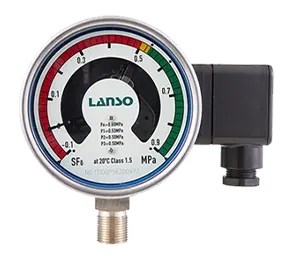Sulfur Hexafluoride (SF6), as an excellent insulating gas, is widely used in high-voltage power equipment. In gas-insulated switchgear (GIS), SF6 gas densitometers play a crucial role. This article will analyze in detail the functions of SF6 gas densitometers and the steps to handle abnormal pressure situations.
Basic Functions of SF6 Gas Densitometers
In GIS systems, SF6 gas densitometers are used to monitor gas density in real-time to ensure the safe operation of the equipment. The gas densitometer calculates the gas density by monitoring the pressure changes of SF6 gas and compares it with the set alarm pressure value and locking pressure value. When the gas density drops to the alarm value, the gas densitometer will issue an alarm signal to remind the operators to refill the gas; when the gas density continues to drop to the locking pressure value, the related equipment will automatically enter a lock state to ensure system safety.
The design of the gas densitometer is closely related to the overall structure of the GIS equipment. Each brake gas chamber is equipped with an independent gas densitometer, not only to improve monitoring accuracy but also to quickly detect potential gas leaks or other abnormal situations.
Analysis of Abnormal Pressure in SF6 Gas Densitometers
During long-term use, SF6 gas densitometers may encounter various pressure abnormal problems, usually caused by aging equipment, environmental changes, or improper operation.
Common problem analysis
Gas leakage: This is the most common cause of gas density reduction. If there is a leak in the equipment, the gas pressure will surely decrease, which affects the gas density measurement.
Density meter failure: The gas densitometer may have internal component aging or damage, such as sensor failure or displaying errors, which could lead to inaccurate monitoring data.
Temperature changes: In outdoor environments, extreme temperature fluctuations caused by direct strong sunlight or icy weather can directly affect the gas pressure and thus impact the density meter readings.
The importance of regular calibration
For various reasons, many devices have not been regularly calibrated after years of use, leading to reduced measurement accuracy of the density meter. Therefore, timely calibration is necessary to effectively prevent potential equipment failures.
Steps to Handle Abnormal Pressure in SF6 Gas Densitometers
When encountering abnormal pressure in the gas densitometer, corresponding measures should be quickly taken to ensure the safe operation of the equipment.
Responding to gas leaks
Immediately stop the operation of related equipment (if possible).
Use a leak detector to quickly locate the leak point and repair it.
Refill SF6 gas to the required pressure level as needed.
Resolving density meter faults
If a density meter failure is found, replace it with a new density meter and calibrate and test it to ensure it functions properly.
Address temperature changes
Wait for the ambient temperature to stabilize, then observe the pressure reading again to confirm if there is still an abnormality.
If the pressure remains abnormal, troubleshoot and solve according to other problems step by step.
The application of SF6 gas densitometers in high-voltage power equipment is vital. By regular monitoring and maintenance, the safe and stable operation of the equipment can be ensured. In the event of abnormal pressure, timely analysis of the causes and effective measures are crucial steps to ensuring the normal operation of the power system. Through scientific and reasonable management, a solid foundation can be provided for the long-term use of the equipment.







